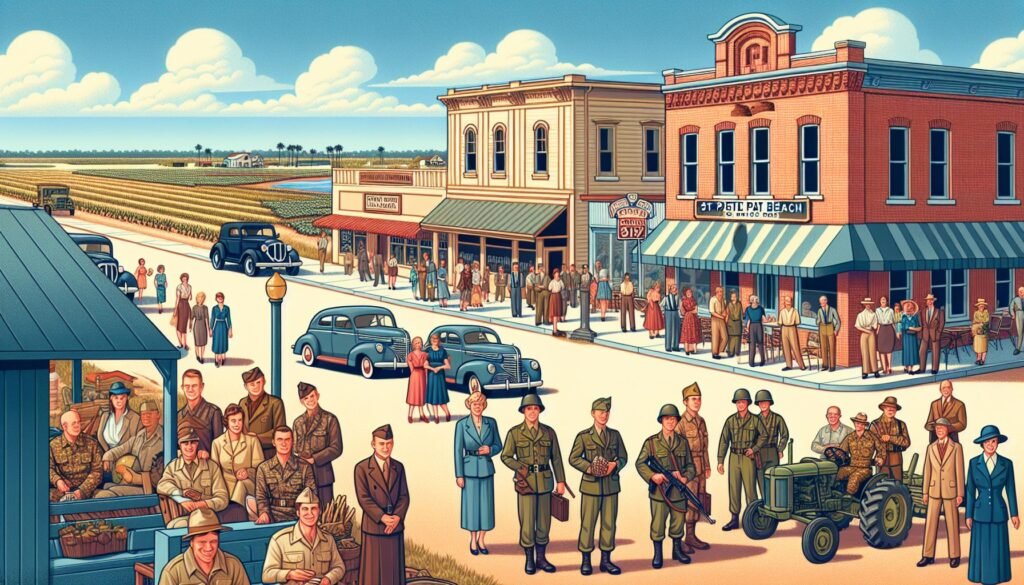Development of Early Tourism Infrastructure
As I delve deeper into the transformation of St. Pete Beach, the development of its early tourism infrastructure stands out as a pivotal chapter in its storied past. Reflecting on it, I’m amazed at how visionaries of the era laid down the groundwork for what this beloved beach town would become.
In the early 20th century, St. Pete Beach was primarily accessible by boat, with few roads leading into the area. The allure of its pristine beaches and the promise of bountiful fishing began to attract more visitors, necessitating the development of basic amenities to accommodate these early tourists. It’s fascinating to think about how the pioneers saw potential in this then-remote locale and began sowing the seeds for its future growth.
One of the most significant milestones in this journey was the construction of the Grand Hotel in 1928. This majestic establishment was a beacon of luxury, offering guests unparalleled comfort and stunning views of the Gulf of Mexico. It’s eyebrow-raising to consider that what was once considered an extravagant venture has now set the tone for the hospitality that St. Pete Beach is renowned for.
The completion of the Gandy Bridge in 1924 provided a much-needed boost, shrinking the travel time for visitors from Tampa and beyond. Suddenly, what used to be an arduous journey turned into a convenient trip, opening the floodgates to a wave of tourists eager to experience the beach’s charm. The bridge wasn’t just a physical connector; it symbolized the linking of St. Pete Beach’s quaint isolation with the bustling activity of the surrounding regions.
- Establishment of local businesses to cater to tourists
- Introduction of trolley services for easier navigation around the beach
- Rental cottages and boarding houses popping up along the coastline
These innovations reflected the community’s adaptability to the burgeoning tourist influx, each step forward making the area more attractive and accessible. I’m particularly struck by how these efforts laid a solid foundation for the thriving tourist economy that we see today.
Transportation to St. Pete Beach
As the sun-kissed beaches and crystal-clear waters of St. Pete Beach began to draw more visitors, the issue of getting there became increasingly important. I’ve always been fascinated by how destinations grow and evolve, and the story of transportation to St. Pete Beach is no exception. It’s a tale of innovation, vision, and the relentless pursuit of making what was once a remote paradise accessible to all.
In the early days, the Gandy Bridge, completed in 1924, was a game-changer. Before its construction, the journey to St. Pete Beach was long and arduous, often deterring would-be visitors. The bridge dramatically shortened the travel time from Tampa and opened the floodgates for tourists eager to experience the pristine shores of St. Pete Beach. The bridge wasn’t just a feat of engineering; it was a bridge to the future of tourism in the area.
Following the success of the Gandy Bridge, the focus shifted to improving the local transportation network. The introduction of trolley services was a significant step forward. These trolleys didn’t just ferry visitors from A to B; they were a symbol of the growing accessibility of St. Pete Beach to the masses. Suddenly, the once exclusive resort town was within reach of anyone yearning for a taste of coastal bliss.
But it wasn’t just about getting to St. Pete Beach; it was also about moving around once you arrived. The establishment of rental accommodations and local businesses near key transport hubs made it convenient for visitors to find lodging and entertainment. This thoughtful planning ensured that tourists could easily explore the area’s attractions, further enriching their holiday experience.
Here are some key developments in transportation to St. Pete Beach:
| Year | Development |
|---|---|
| 1924 | Completion of the Gandy Bridge |
| 1928 | Introduction of Trolley Services |
These advancements were instrumental in shaping the tourist economy of St. Pete Beach. They reflected a forward-thinking approach to tourism infrastructure, one that understood the importance of accessibility and convenience. The early visionaries of St. Pete Beach weren’t just building roads and bridges; they were laying down the pathways to a vibrant, thriving community that welcomed visitors from near and far.
First Accommodation Options for Tourists
When I first delved into the history of tourism in St. Pete Beach, it was intriguing to see how the lodging options evolved to cater to the early visitors. The initial accommodations for tourists were primarily small inns and rental cottages, which were both modest and somewhat sparse. These were the pioneers in the hospitality industry of St. Pete Beach, setting the stage for what would become a flourishing sector.
One of the first standout establishments was The Don CeSar Hotel. Opened in 1928, The Don CeSar dazzled visitors with its grandeur and luxury, a stark contrast to the simpler lodging of the time. Nicknamed the “Pink Palace” for its distinctive color, this hotel represented a new era of tourist accommodation, combining lavish architecture with unprecedented levels of service and comfort. It wasn’t just a place to stay; it was an experience, attracting visitors from all over the country.
Besides The Don CeSar, smaller boarding houses and beachside cottages began to gain popularity among tourists seeking a more homely aura. These accommodations were pivotal because they offered tourists an intimate and personalized stay, fundamentally different from the larger hotels. Owners would often live on-site, adding a personal touch to the hospitality that guests received. This was the beginning of what would become a hallmark of St. Pete Beach’s tourist appeal – the warmth and friendliness of its accommodations.
By the 1930s, the landscape of tourist accommodations began to diversify further. The establishment of motels along the main roads leading to St. Pete Beach catered to the growing number of tourists driving down from the northern states. This shift was significant, reflecting the changing preferences of tourists who valued convenience and accessibility. These motels were simpler than The Don CeSar but provided a comfortable and affordable stay for families and individual travelers alike.
Attractions and Activities for Early Tourists
St. Pete Beach has always been a magnet for those seeking sunshine and sand, but it was the attractions and activities that really cemented its status as a premier tourist destination in the early days. I’ve discovered that even back then, tourists had a myriad of ways to soak up the beauty and excitement of this coastal paradise.
One of the biggest draws was, naturally, the beach itself. It wasn’t just about sunbathing or swimming; early visitors were treated to picnics on the pristine sands, volleyball games, and even impromptu beachside concerts. Imagine donning your finest bathing attire for a leisurely stroll down the shore, or perhaps joining in on a spirited game of beach cricket. It sounds like a scene straight out of a postcard from the past, doesn’t it?
Fishing and boating were also incredibly popular. Many tourists would rent small boats for the day to explore the gulf and its abundant marine life. There’s something timelessly captivating about setting sail on the open water, rod in hand, waiting for that thrilling tug of a catch. Fishing tournaments became a summer staple, drawing crowds eager to witness or partake in the competitive excitement.
The vibrant community life of St. Pete Beach offered another layer of attraction. Seasonal festivals and outdoor markets were common, bringing together locals and tourists in celebration of everything from the local catch to handmade crafts. I can just picture the scenes: streets lined with colorful stalls, the air filled with laughter and music, and everyone coming together to enjoy the simple pleasures of seaside living.
Last but certainly not least were the natural attractions. Not far from the busy beachfronts, early tourists could explore quieter, untouched parts of the coast and its surroundings. Guided nature walks through local parks and reserves introduced visitors to the unique flora and fauna of the area. For those looking for a bit of adventure, there were opportunities for kayaking through mangrove tunnels or even taking a guided moonlight paddle.
As I delve deeper into the history and charm of St. Pete Beach, I’m reminded of how these early attractions and activities laid the foundation for the thriving tourism culture that exists today. It’s fascinating to see how the essence of what made St. Pete Beach so appealing in the past has been preserved and continues to draw visitors from around the world.
Preservation of Historical Landmarks
As the popularity of St. Pete Beach as a tourist destination grew, so did the understanding of the importance of preserving its historical landmarks. I’ve always been fascinated by how communities manage to retain their charm while embracing modernity, and St. Pete Beach is no exception. Here, the past and present merge seamlessly, offering a unique glimpse into the area’s rich history.
One of the most iconic landmarks that have been preserved over the years is the Don CeSar Hotel. Often referred to as the Pink Palace, this grand hotel has been a symbol of luxury and respite for visitors since the 1920s. It’s not just a place to stay; it’s a piece of history that tells stories of glamour, resilience, and the evolution of tourism in St. Pete Beach. Efforts to maintain its original architecture while providing contemporary comforts have ensured that the Don CeSar remains a cherished landmark.
Another testament to the commitment to preservation in St. Pete Beach is Pass-a-Grille, the historic neighborhood known for its quaint shopping areas and old Floridian charm. Walking through Pass-a-Grille is like stepping back in time, with its preserved cottages, narrow streets, and the historic 8th Avenue, touted as the nation’s shortest main street. This area embodies the spirit of early St. Pete Beach, where the community’s connection to its history is palpable.
Preservation efforts in St. Pete Beach also extend to its natural landmarks. The area’s beautiful beaches, indigenous flora, and fauna are part of its allure, inviting not only tourists but also researchers and conservationists. Initiatives to protect its coastal and marine ecosystems ensure that St. Pete Beach remains a haven for wildlife and a place where visitors can enjoy unspoiled natural beauty.
One cannot talk about preservation without mentioning the local efforts to maintain the cultural heritage of St. Pete Beach. Community-led festivals, such as the historical Fish Broil and Mullet Festival, continue to thrive, celebrating the area’s fishing heritage and bringing together residents and tourists in a festive reflection of the past. Such events are crucial in keeping the history of St. Pete Beach alive, offering immersive experiences that highlight the area’s traditions and community spirit.
Conclusion
I’ve loved exploring how St. Pete Beach has managed to honor its rich history while still evolving into a vibrant tourist hotspot. It’s clear that the heart of this community lies not just in its stunning landscapes but in the collective effort to keep its heritage alive. From the majestic Don CeSar Hotel to the quaint streets of Pass-a-Grille, there’s a story behind every corner. And let’s not forget the festivals that bring everyone together, celebrating a culture that’s uniquely theirs. It’s this blend of preservation and progress that makes St. Pete Beach a truly special place to visit. So if you’re ever in the area, take a moment to appreciate not just the views but the spirit of a community that’s worked hard to keep its history shining bright.



